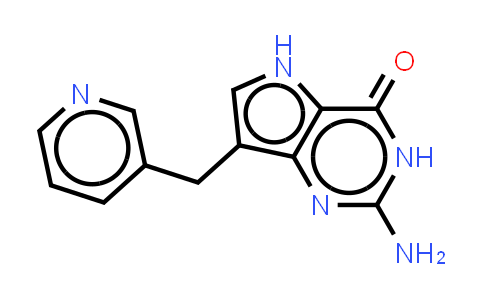| Chemical Name |
Peldesine |
| CAS Number |
133432-71-0 |
| MDL Number |
MFCD00866504 |
| Molecular Formula |
C12H11N5O |
| Molecular Weight |
241.25 |
| Synonyms |
BCX 34 |
Introduction of 133432-71-0 :
Peldesine (BCX 34) is a potent, competitive, reversible and orally active purine nucleoside phosphorylase (PNP) inhibitor with IC50s of 36 nM, 5 nM, and 32 nM for human, rat, and mouse red blood cell (RBC) PNP, respectively. Peldesine is also a T-cell proliferation inhibitor with an IC50 of 800 nM. Peldesine has the potential for cutaneous T-cell lymphoma, psoriasis and HIV infection treatment[1][2][3][4]. IC50 & Target: IC50: 36 nM (Human RBC PNP), 5 nM (Rat RBC PNP), 32 nM (Mouse RBC PNP), and 800 nM (Human T-cell proliferation)[3]
Ki: 23 nM (Human RBC PNP)[3]
HIV[4] In Vitro: Peldesine (BCX 34; 0-50 µM; 72 hours; Jurkat cells) could inhibit the T-cell proliferation completely at a concentration of less than 10 μM, in the presence of dGuo (10 μM). In contrast, the B-cell proliferation is not affected by Peldesine[1].
Peldesine (BCX 34) suppresses T-cell immune reaction in an IL-2-independent manner, and this means that Peldesine might affect a late phase rather than an early stage in T-cell activation[1].
Peldesine also, in the presence but not in the absence of deoxyguanosine, inhibits human leukemia CCRF-CEM T-cell proliferation with an IC50 of 0.57 μM but not rat or mouse T-cell proliferation up to 30 μM[3]. In Vivo: Oral bioavailability of Peldesine in rats is 76%. Peldesine is orally active in elevating plasma inosine in rats (2-fold at 30 mg/kg), in suppressing ex vivo RBC PNP activity in rats (98% at 3 h. 100 mg/kg), and in suppressing ex vivo skin PNP in mice (39% at 3 h, 100 mg/kg)[3].
| Purity |
NLT 98% |
| Storage |
at 20ºC 2 years |
*The above information is for reference only.
